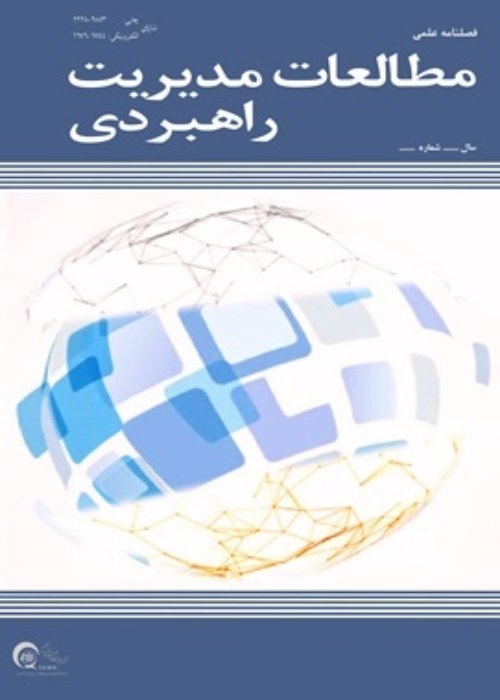A strategic pattern of higher education management with emphasis on the concept of governance
Author(s):
Article Type:
Research/Original Article (دارای رتبه معتبر)
Abstract:
Introduction
The present article seeks to provide a model based on which the attraction and effectiveness of higher education management graduates in the higher education governance system in Iran explained. The need to examine this issue explored in the sense that the issue of lack of effective and useful attraction of graduates of higher education courses in the labor market is one of the problems arising from an inefficient education system. Therefore, formulating and designing a set of strategies and policies that can be relied on to create the conditions for the proper presence of graduates of the higher education system in a suitable and correct job environment is very necessary for any system. Given the importance of achieving efficiency, success and productivity in higher education and governance of higher education, it seen that some important aspects of attracting graduates have been neglected or forgotten. The main concern in this study is what are the components of attracting and influencing graduates of higher education management in the governing system of higher education in Iran to provide a favorable model in Iran? The present study has two categories of objectives. Theoretically, it seeks to provide a comprehensive perspective in order to provide a clearer understanding of the components of attracting and influencing graduates of higher education management in the governing system of higher education in Iran. From a practical point of view, since the higher education system and its scientific and human resources are considered as the most important assets of any country, so strengthening the expertise in this field and helping decision makers to recognize challenges and adopt Policies appropriate to the country's higher education system are considered by the authors. The present study has two categories of objectives. Theoretically, it seeks to provide a comprehensive perspective in order to provide a clearer understanding of the components of attracting and influencing graduates of higher education management in the governing system of higher education in Iran. In practical terms, since the higher education system and its scientific and human resources are considered the most important assets of any country, so strengthening the expertise in this area and helping decision-makers to recognize challenges and adopt Policies appropriate to the country's higher education system are considered by the authors. Methodology
The present study is qualitative in terms of type and is based on data strategy and formed by Corbin and Strauss approach. According to the purpose of this study, which is to identify and study the components of attracting and influencing graduates of higher education management in the higher education system of Iran, the research design is a qualitative research design with data method. This approach is based on the three main steps of open coding, axial coding, and selective coding and was performed using Max qda software version 2018. The validity of the qualitative part with continuous and long-term involvement strategies of the researcher was achieved through the process of collecting and analyzing research data, reviewing and controlling colleagues, and validating the participation of participants used. And the researcher will benefit from semi-structured interviews based on data foundation theory. Results and Discussion
The main categories and sub-components presented based on open and centralized coding of data obtained from in-depth and exploratory interviews with key experts and refinement of conceptual codes. Accordingly, in order to perform open and pivotal coding in the first stage, the data at the sentence and phrase level for each of the interviews examined and conceptual codes extracted from the transcripts of the interviews. By refining and reducing, these components organized into sub-categories and named by continuous review. In order to ensure the proper organization of each of the concepts and categories, the transcripts of the interviews were re-examined and reviewed by these categories in order to achieve a logical saturation for the main categories and sub-categories. In general, from the analysis of qualitative data of the research in the coding stage, 329 initial conceptual codes obtained. After reviewing and matching these codes and removing duplicate codes, common codes counted. Conclusion
One of the things that needs to explain is identifying possible barriers to attracting graduates of higher education management and trying to overcome them in governing higher education. In this regard, the scope of studies and views is very limited. In fact, the possibility of attracting graduates of higher education management, on the one hand, motivates them and participates in decision-making, and on the other hand, it includes responsibility, improving managerial capacity and planning, improving the quality of education and research for them. , That these competencies can prevent them from being passive because if policies and programs are formulated by graduates, they will consider themselves partners in the decisions they have made and will try to Fulfill their goals and missions and no longer have an excuse to blame others for the failure of programs. Given that the university is the workplace of professional students and they are able better than anyone else to formulate a system of governance, neglecting to attract and influence them will motivate students. Therefore, it is worth investing more in attracting graduates.The present article seeks to provide a model based on which the attraction and effectiveness of higher education management graduates in the higher education governance system in Iran can be explained. The present research is applied in terms of purpose and in terms of descriptive-survey nature and has been done within the framework of a qualitative approach and using the data research method of the foundation. Targeted interviews were conducted with 18 experts, managers and higher education experts. After open, axial and selective triple coding, the conceptual model of the research was designed based on a paradigm model. The research findings indicate that this model is in the form of 25 main categories and 82 variables, including the recruitment and use of graduates as the core or main category of the model; Causal variables (organizational factors, extra-organizational factors, readiness to absorb and apply, intrapersonal competencies, personal competencies and entrepreneurial competencies); Background variables (work context, upstream documents); Interventional conditions (culture of job creation, sustainability of existing systems, talent discovery, accountability); Strategic categories (institutionalization of entrepreneurial talent management system, design of multiple entrepreneurial talent management process and design of resource allocation system) and finally consequential categories (job creation, value creation and multiple competitive advantage, creating quality assurance in higher education system) were included. The present article seeks to provide a model based on which the attraction and effectiveness of higher education management graduates in the higher education governance system in Iran can be explained. The present research is applied in terms of purpose and in terms of descriptive-survey nature and has been done within the framework of a qualitative approach and using the data research method of the foundation. Targeted interviews were conducted with 18 experts, managers and higher education experts. After open, axial and selective triple coding, the conceptual model of the research was designed based on a paradigm model. The research findings indicate that this model is in the form of 25 main categories and 82 variables, including the recruitment and use of graduates as the core or main category of the model; Causal variables (organizational factors, extra-organizational factors, readiness to absorb and apply, intrapersonal competencies, personal competencies and entrepreneurial competencies); Background variables (work context, upstream documents); Interventional conditions (culture of job creation, sustainability of existing systems, talent discovery, accountability); Strategic categories (institutionalization of entrepreneurial talent management system, design of multiple entrepreneurial talent management process and design of resource allocation system) and finally consequential categories (job creation, value creation and multiple competitive advantage, creating quality assurance in higher education system) were included.Keywords:
Language:
Persian
Published:
Journal of Strategic Management Studies, Volume:14 Issue: 53, 2023
Pages:
127 to 145
magiran.com/p2580069
دانلود و مطالعه متن این مقاله با یکی از روشهای زیر امکان پذیر است:
اشتراک شخصی
با عضویت و پرداخت آنلاین حق اشتراک یکساله به مبلغ 1,390,000ريال میتوانید 70 عنوان مطلب دانلود کنید!
اشتراک سازمانی
به کتابخانه دانشگاه یا محل کار خود پیشنهاد کنید تا اشتراک سازمانی این پایگاه را برای دسترسی نامحدود همه کاربران به متن مطالب تهیه نمایند!
توجه!
- حق عضویت دریافتی صرف حمایت از نشریات عضو و نگهداری، تکمیل و توسعه مگیران میشود.
- پرداخت حق اشتراک و دانلود مقالات اجازه بازنشر آن در سایر رسانههای چاپی و دیجیتال را به کاربر نمیدهد.
In order to view content subscription is required
Personal subscription
Subscribe magiran.com for 70 € euros via PayPal and download 70 articles during a year.
Organization subscription
Please contact us to subscribe your university or library for unlimited access!



